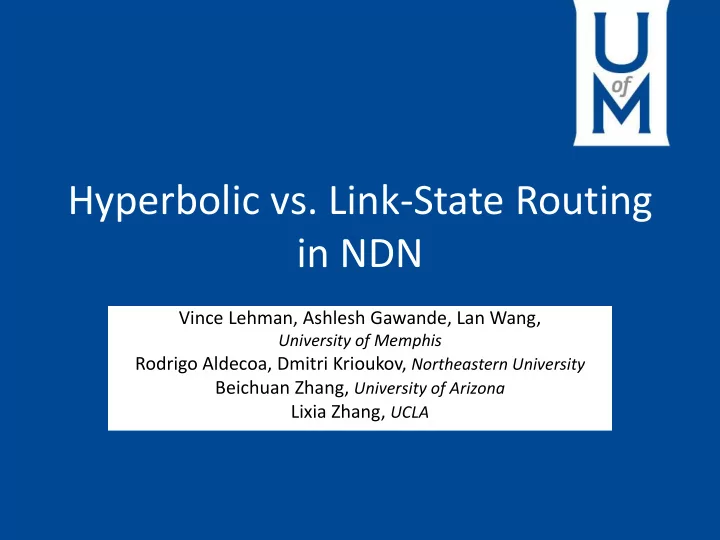

Hyperbolic vs. Link-State Routing in NDN Vince Lehman, Ashlesh Gawande, Lan Wang, University of Memphis Rodrigo Aldecoa, Dmitri Krioukov, Northeastern University Beichuan Zhang, University of Arizona Lixia Zhang, UCLA
Routing Scalability in NDN • Forwarding Information Base (FIB) in NDN could grow at an unmanageable rate • Number of routing updates (overhead) to maintain consistent FIBs may also be costly • NDN networks must scale in terms of name prefixes and routing protocol overhead
Hyperbolic Routing Greedy geographic routing based on hyperbolic coordinates that encode network geometry Destination Next hops D {A, cost=10}, {B, cost=30} To forward a packet: – Find the neighbor closest to the destination – Forward the packet to that neighbor 3
Hyperbolic Routing Greedy geographic routing based on hyperbolic coordinates that encode network geometry Destination Next hops D {A, cost=10}, {B, cost=30} To forward a packet: – Find the neighbor closest to the destination – Forward the packet to that neighbor 3
Hyperbolic Routing Greedy geographic routing based on hyperbolic coordinates that encode network geometry Destination Next hops D {A, cost=10}, {B, cost=30} To forward a packet: – Find the neighbor closest to the destination – Forward the packet to that neighbor 3
Why Hyperbolic Routing (HR)? • In the ideal case, no FIB is B needed • Low communication cost S D Few routing updates, as coordinates rarely change A • Drawbacks? – Suboptimal paths – Local minima Local minima (Closest to D but no – Does not react to network connection) dynamics • How to mitigate these drawbacks?
Forwarding Strategy • Use Hyperbolic Routing’s ranking as a hint, but probe alternative routes periodically • Adaptive SRTT-Based Forwarding – Best SRTT-Based Forwarding – Probabilistic SRTT-Based Probing
HR Deployment in NDN • Interest carries name and coordinates • Forwarder picks next hop using neighbors’ distances to coordinates • Consumer can fetch coordinates from a distributed database (e.g. NDNS) • Note : Name is first Coordinate Database (e.g., NDNS) Request matched against coordinates Coordinates CS, so still Data Radius: 12.34 Angle: 1.23 Forwarder centric ✗ ✗ ✓ Content Route Forwarding Consumer PIT Store Cache Strategy Interest Forward Coordinates ✓ ✓ ✗ ... Data Add incoming Calculate interface route
Evaluation Goals • We know HR has no FIB and updates, but: – Under HR, can forwarding strategy find optimal paths during failures and recoveries? – Is performance similar to link-state routing implemented by Named Data Link-State Routing (NLSR)? – Is probing overhead less than update overhead? – Does overhead scale as topology size increases?
Delay Stretch Hyperbolic routing/ ASF’s delay stretch (over Link State Routing) has median close to 1 and 95th-percentile below 2.
Loss Rate
Message Overhead LS vs HR Per Node Overhead Under MCN Failure # Nodes LS Overhead HR Overhead 22 2.2 pps 0.28 pps 41 7.8 pps 0.28 pps 58 17.5 pps 0.36 pps 78 39.4 pps 0.47 pps
Recommend
More recommend